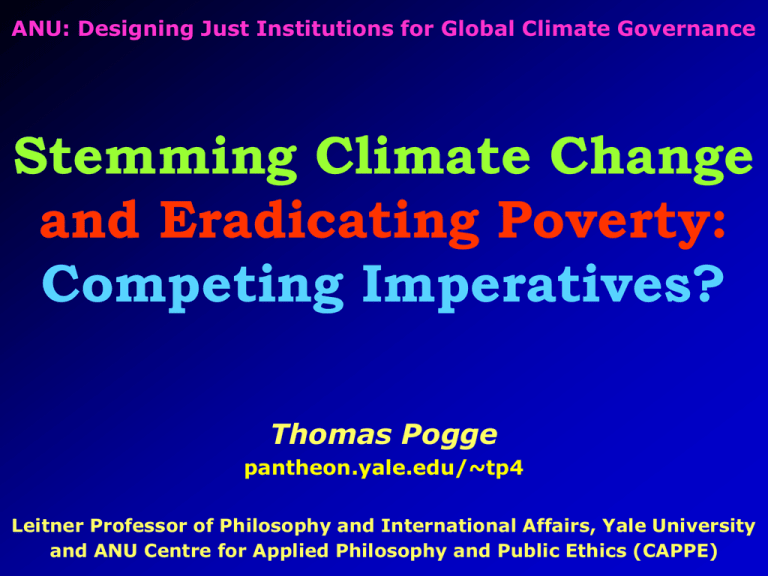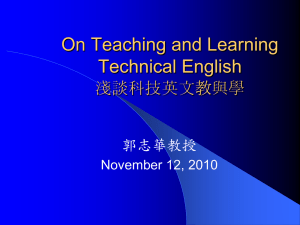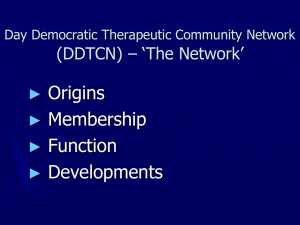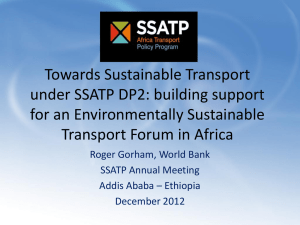Pogge_presentation
advertisement

ANU: Designing Just Institutions for Global Climate Governance Stemming Climate Change and Eradicating Poverty: Competing Imperatives? Thomas Pogge pantheon.yale.edu/~tp4 Leitner Professor of Philosophy and International Affairs, Yale University and ANU Centre for Applied Philosophy and Public Ethics (CAPPE) 1 The Human Magnitude of World Poverty 1 Deprivations of Poverty Among ca. 7 billion human beings, about 925 million are chronically undernourished (FAO 2010), 2000 million lack access to essential drugs (www.fic.nih.gov/about/plan/exec_summary.htm), 884 million lack safe drinking water (WHO/UNICEF 2008, 32), 924 million lack adequate shelter (UN Habitat 2003, p. vi), 1600 million have no electricity (UN Habitat, “Urban Energy”), 2500 million lack adequate sanitation (WHO/UNICEF 2008, p. 7), 796 million adults are illiterate (www.uis.unesco.org), 218 million children (aged 5 to 17) do wage work outside their household — often under slavery-like and hazardous conditions: as soldiers, prostitutes or domestic servants, or in agriculture, construction, textile or carpet production (ILO: The End of Child Labour, Within Reach, 2006, pp. 9, 11, 17-18). 2 Millions of Deaths 3 2 The “True Cost” of Fighting Poverty 4 Causality -Pov +Pop • Reductions in poverty increase human population as those who escape extreme poverty will enjoy longer lives. The effect is large, as about half of current annual poverty deaths (9 out of 18 million) are children under 5. If we enable these children to survive, most of them will reproduce (and thereby aggravate ecological burdens). 5 Causality +Pop -Ecol • Climate change and ecological burdens more generally (including depletion of non-renewable natural resources) are correlated with population. There is no reason to think that ecological footprint per person declines meaningfully with the number of persons. Therefore, more people means more rapid exhaustion of our planetary resources. Conclusion: -Pov -Ecol 6 3 Some Benefits of Fighting Poverty 7 Causality -Pov +Ecol • Dire need often compels very poor people to act in environmentally destructive ways for short-term benefit. • Pro-poor policies and institutional arrangements entail ecological benefits insofar as economists are right to claim that they “sacrifice” aggregate growth. 8 Causality -Pov -Pop As Amartya Sen was the first to point out (NYRB 1994), there is a very high correlation between poverty and total fertility rates. Since 1955, the TFR has changed in East Asia from 5.42 to 1.72, in Portugal from 3.04 to 1.38, in Australia from 3.18 to 1.83 – versus from 5.50 to 5.36 in Equatorial Guinea, from 6.23 to 5.49 in Mali, from 6.86 to 7.15 in Niger, and from 5.52 to 5.22 in Sierra Leone. http://esa.un.org/unpp/index.asp?panel=2. 9 Colombia Botswana Eq.Guinea Niger Singapore 1950-1955 6.76 6.50 5.50 6.86 6.40 1955-1960 6.76 6.58 5.50 7.05 5.99 1960-1965 6.76 6.65 5.53 7.29 4.93 1965-1970 6.18 6.70 5.66 7.53 3.46 1970-1975 5.00 6.55 5.68 7.74 2.62 1975-1980 4.34 6.37 5.68 8.00 1.87 1980-1985 3.68 5.97 5.79 8.05 1.69 1985-1990 3.24 5.11 5.89 7.94 1.71 1990-1995 3.00 4.32 5.89 7.79 1.76 1995-2000 2.75 3.70 5.87 7.61 1.57 2000-2005 2.55 3.18 5.64 7.38 1.36 2005-2010 2.45 2.90 5.36 7.15 1.27 10 -Pov -Pop continued Currently, the total fertility rate is 4.39 for the 50 least developed countries versus 1.64 for the more developed regions, and 2.46 for the remaining middle-income countries http://esa.un.org/unpp/index.asp?panel=2 Already 95 of the richer countries have reached TFRs below 2.00, half of countries below 2.20. https://www.CIA.gov/library/publications/the-worldfactbook/rankorder/2127rank.html Despite vastly higher mortality, the poor have rapid population growth, the better-off little or none. 11 Rank country 1 Niger 2 Uganda 3 Mali 4 Somalia 5 Burundi 6 Burkina Faso 7 Congo, Democratic Republic of the 8 Ethiopia 9 Zambia 10 Angola 11 Congo, Republic of the 12 Malawi 13 Afghanistan 14 Benin 15 Mayotte (children born/woman) Date of Information 7.68 6.73 6.54 6.44 6.25 6.21 6.11 6.07 6.07 6.05 5.77 5.51 5.50 5.40 5.40 2010 est. 2010 est. 2010 est. 2010 est. 2010 est. 2010 est. 2010 est. 2010 est. 2010 est. 2010 est. 2010 est. 2010 est. 2010 est. 2010 est. 2010 est. 12 Rank country 151 Kazakhstan 152 Aruba 153 Wallis and Futuna 154 Maldives 155 Saint Lucia 156 Virgin Islands 157 Mauritius 158 Saint Kitts and Nevis 159 Australia 160 Luxembourg 161 Lebanon 162 Norway 163 Algeria 164 Anguilla 165 Denmark (children born/woman) Date of Information 1.87 1.85 1.84 1.83 1.82 1.81 1.80 1.79 1.78 1.78 1.78 1.77 1.76 1.75 1.74 2010 est. 2010 est. 2010 est. 2010 est. 2010 est. 2010 est. 2010 est. 2010 est. 2010 est. 2010 est. 2010 est. 2010 est. 2010 est. 2010 est. 2010 est. 13 Rank country (children born/woman) Date of Information 2010 est. 2010 est. 211 Slovenia 212 Moldova 213 Romania 214 Ukraine 215 Bosnia and Herzegovina 216 Belarus 217 Czech Republic 218 Montserrat 219 Lithuania 220 Korea, South 221 Japan 222 Taiwan 223 Singapore 224 Hong Kong 1.29 1.28 1.27 1.27 1.26 1.25 1.25 1.25 1.24 1.22 1.20 1.15 1.10 1.04 225 Macau 0.91 2010 est. 2010 est. 2010 est. 2010 est. 2010 est. 2010 est. 2010 est. 2010 est. 2010 est. 2010 est. 2010 est. 2010 est. 2010 est. 14 4 Common Driver of Poverty and Ecological Harm 15 Supranational Institutional Arrangements are becoming increasingly influential (an aspect of globalization), and are shaped in intergovernmental negotiations - that lack transparency and accountability, - while denying consideration to the input and interests of the vast majority of humanity - and while affording enormous influence to those corporations, industry associations, banks and other powerful agents who can lobby the principal governments. 16 Systemic Problem: Regulatory Capture with Inequality Spiral Often in concert, the richest players influence the rules and their application, thereby expanding their own advantage. Such run-away inequality strengthens, in each round, both the incentives and the opportunities for influence. Public facilities come under the influence of players with special and often near-term interests — who buy support from media and academics for this purpose (venality esp. of economists who live up to their homo oeconomicus paradigm). Special interests have been effective in influencing especially international agreements (WTO Treaty) and organizations (WIPO, IMF, World Bank). 17 Segment of World Population Richest Ventile Next Four Ventiles Second Quarter Third Quarter Poorest Quarter Share of Share of Global Global Household Household Income Income 1988 2005 Absolute Relative Change in Change in Income Income Share Share 42.87 46.36 +3.49 +8.1% 46.63 43.98 -2.65 -5.7% 6.97 6.74 -0.23 -3.3% 2.37 2.14 -0.23 -9.8% 1.15 0.77 -0.38 -32.9% Data courtesy of Branko Milanovic 18 5 Gathering Diverse Interests for Reform 19 Structural Reforms Those with an interest safeguarding our environment, in moderating inequality and/or in reducing poverty should develop global institutional reform ideas that also appeal to the generic interest in stability (in controlling regulatory capture) and to specific interests in private gain. 20 An Example of Reform If inventors of green technologies are rewarded through patent-protected mark-ups, their inventions are bound to be underutilized. Instead: offer to reward such inventors for a similar time period (15 years?) with payments proportional to the ecological harm their invention averts – on condition that they license and/or sell their invention at no more than, respectively, zero cost or the lowest 21 feasible marginal cost of production. 22 Two Different Adaptations Extension to pharmaceutical innovation: pay pharmaceutical innovators for ten years based on the global health impact of their new medicine (www.healthimpactfund.org). Extension to agricultural innovation: pay innovators on the basis of incremental nutrients produced through use of their invention on the fields where it is deployed. 23





